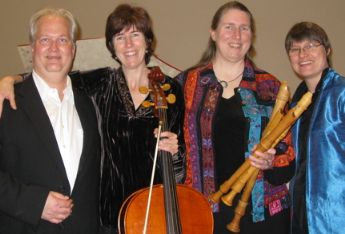|
Chamber
FRISSON DELIVERS SHIVERS OF DELIGHT
by Abby Wasserman
Sunday, March 30, 2025
Chamber
THE PARKER CAPTURES DEMANDING ADES QUARTET AT RAC SEBASTOPOL CONCERT
by Peter Lert
Saturday, February 15, 2025
Chamber
SPLENDID ECHOES ACROSS THE BAY
by Abby Wasserman
Sunday, February 9, 2025
ETHEREAL DUO IN WEILL HALL RECITAL
by Pamela Hicks Gailey
Thursday, February 6, 2025
ESPANA SEGURO AT SO CO PHIL'S JACKSON THEATER CONCERT
by Terry McNeill
Sunday, February 2, 2025
Choral and Vocal
MASTERFUL SINGING CLASS IN SCHROEDER HALL
by Pamela Hicks Gailey
Sunday, February 2, 2025
Recital
MUSICAL POT POURRI AT SPRING LAKE VILLAGE RECITAL
by Terry McNeill
Friday, January 31, 2025
CELLO AND CLARINET HIGHLIGHT TRIO NAVARRO'S CONCERT
by Ron Teplitz
Sunday, January 26, 2025
SONGS OF LOVE, IN A WARM TRIO
by Pamela Hicks Gailey
Sunday, January 26, 2025
Symphony
EARTHLY PLEASURES AT THE VALLEJO SYMPHONY
by Peter Lert
Sunday, January 19, 2025
|
 |
 Vermillian Ensemble On Stage in Santa Rosa's Sophia Hall |
EARLY MUSIC VIRTUOSITY FROM THE VERMILLIAN EMSEMBLE
by Joanna Bramel Young
Saturday, January 2, 2010
Summerfield Waldorf School in Santa Rosa hosted a concert January 2 in their handsome West Santa Rosa Sophia Hall, featuring the Vermillian Ensemble.
Frances Blaker, well-known to Bay Area recorder players as both a teacher and performer, brought a handful of fine baroque recorders to perform works for recorder, violin, cello and harpsichord. She and baroque violinist David Wilson treated an appreciative audience that filled the hall to a variety of trio sonatas, accompanied by baroque cellist Barbara Blaker-Krumdieck and harpsichordist Hanneke van Proosdij. Ms. Blaker, in order to extend the repertoire possibilities of the recorder, took on the project of finding interesting works written for two violins and basso continuo and arranging one of the violin parts for recorder. This was a frequent practice in the 17th and 18th centuries, where the title page would often read “May be played on flute, oboe or violin.” This practice of course helped sell more music to players of different instruments. Ms. Blake explained her reason for undertaking the project by telling the audience, “I love to play the recorder, but I love to listen to the violin.”
The program’s first work was a trio sonata by Corelli, the Roman composer known for his sweet melodies and clear, defined bass lines. The sparkling last Allegro allowed the recorder, in the hands of Ms. Blaker, to demonstrate abundant facility and instrumental mastery. Cello and harpsichord provided sensitive support to the upper voices. The next piece was by Giovanni Battista Fontana (1589?-1630?), the earliest composition on the program. Fontana, along with the better known Frescobaldi, was a Venetian composer writing pieces in the “stilo moderno” (modern style) which was in vogue in the years after 1600.
This style influenced composers for the next hundred years, and one of its characteristics was, rather than having each movement separated by a pause, which later sonatas exhibited, one movement ran seamlessly into the next. The last note of the Adagio segment would be the first note of the next Allegro. These works involve brilliant flashes of ornamentation, and the whole piece was meant to sound like an improvisation. Ms. Blaker used a soprano recorder which was a copy of an instrument appropriate to the period. Passionate extended notes at the beginning, echoed by harpsichord and cello, were followed by virtuosic runs, requiring intense and expressive articulation among the three players. A quick dance in 6/8 suddenly appears out of an Adagio to end the piece with great energy.
Hanneke van Proosdij demonstrated her virtuosity with a captivating work for solo harpsichord by Joseph Hector Fiocco (1703-1741). She began in the low register using the pungent lute stop, letting the right hand enter later in the louder, more singing “regular” register, creating a moving duet between bass and treble. Ms. van Proosdij is not only known as a harpsichordist, but also a performer on the recorder. Her own vermillion scarlet Dutch made harpsichord provided a fitting setting for the Ensemble Vermillian.
David Wilson exhibited a passionate style in performing the “Sonata Quarta” by Johann Heinrich Schmelzer (c.1620-1680). Mr. Wilson mentioned that Schmelzer was one of the great violinists of his generation, and related to the audience that this work “showed how much fun it is to play the violin.” The harpsichord and cello began with an absolutely simple ground bass of four descending notes, over and over, as Mr. Wilson “vamped” over the four notes in a series of brilliant variations.
The program ended with Buxtehude, where the recorder and violin were able to show their mettle in long solo passages with harpsichord and cello, all merging together into a rich ensemble sound.
|

